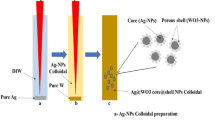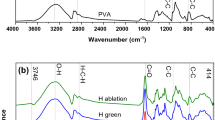Abstract
Q-switched Nd:YAG laser of 1064 nm wavelength was used to synthesize Pd@Ag (core/shell) nanoparticles (NPs) using pulsed laser ablation in distilled water. The synthesized Pd@Ag core–shell NPs were characterized by UV–visible spectrophotometry, Fourier-transform infrared (FT-IR), X-ray diffraction (XRD), transmission electron microscopy (TEM), and energy-dispersive spectroscopy (EDS). UV–vis spectra clearly showed absorption peaks at around 200 and 405 nm, which are caused by surface plasmon resonance on Pd NPs and Ag NPs, respectively. X-ray diffraction analysis showed that Pd NPs and Ag NPs had a crystalline nature with face-centered cubic structure. The TEM images clearly displayed the core-spherical shell’s shape of produced Pd@Ag NPs, with an average particle size ranging from 65 to 350 nm. Antibacterial activities of Pd@Ag core–shell NPs were investigated using well diffusion method. Pd@Ag core–shell NPs exhibited higher antimicrobial effect against Gram-positive pathogens than Gram-negative strain. Pd NPs, on the other hand, had no significant antibacterial activity compared to Pd@Ag core–shell NPs due to their nontoxicity. Herein, we present results demonstrating the excellent antibacterial action of PLAL-prepared Pd@Ag core–shell nanoparticles to kill microbial organisms. These characteristics distinguish this nanostructure for use in antimicrobial applications.







Similar content being viewed by others
Data Availability
The article includes all information.
References
Fernández-Arias M, Vilas AM, Boutinguiza M, Rodríguez D, Arias-González F, Pou-Álvarez P, Riveiro A, Gil J, Pou J (2022) Palladium nanoparticles synthesized by laser ablation in liquids for antimicrobial applications. Nanomaterials 12(15):2621
Murray CJ, Ikuta KS, Sharara F, Swetschinski L, Aguilar GR, Gray A, Han C, Bisignano C, Rao P, Wool E, Johnson SC (2022) Global burden of bacterial antimicrobial resistance in 2019: a systematic analysis. The Lancet 399(10325):629–655
W Raut R, Nikam T, Kashid SB, S Malghe Y (2013) Rapid biosynthesis of platinum and palladium metal nanoparticles using root extract of Asparagus racemosus Linn. Adv Mater Lett 4(8):650–654
Davies J, Davies D (2010) Origins and evolution of antibiotic resistance. Microbiol Mol Biol Rev 74(3):417–433
Al-Omar MS, Jabir M, Karsh E, Kadhim R, Sulaiman GM, Taqi ZJ, Khashan KS, Mohammed HA, Khan RA, Mohammed SA (2021) Gold nanoparticles and graphene oxide flakes enhance cancer cells’ phagocytosis through granzyme-perforin-dependent biomechanism. Nanomaterials 11(6):1382
Boucher HW, Talbot GH, Bradley JS, Edwards JE, Gilbert D, Rice LB, Scheld M, Spellberg B, Bartlett J (2009) Bad bugs, no drugs: no ESKAPE! An update from the Infectious Diseases Society of America. Clin Infect Dis 48(1):1–12
Ding X, Yuan P, Gao N, Zhu H, Yang YY, Xu QH (2017) Au-Ag core-shell nanoparticles for simultaneous bacterial imaging and synergistic antibacterial activity. Nanomedicine: Nanotechnology, Biology and Medicine, 13(1):297–305
Yang L, Yan W, Wang H, Zhuang H, Zhang J (2017) Shell thickness-dependent antibacterial activity and biocompatibility of gold@ silver core–shell nanoparticles. RSC Adv 7(19):11355–11361
Hamad A, Khashan KS, Hadi A (2020) Silver nanoparticles and silver ions as potential antibacterial agents. J Inorg Organomet Polym Mater 30(12):4811–4828
MubarakAli D, Kim H, Venkatesh PS, Kim JW, Lee SY (2022) A systemic review on the synthesis, characterization, and applications of palladium nanoparticles in biomedicine. Applied Biochemistry and Biotechnology 1–20
Bakr EA, El-Attar HG, Salem MA (2019) Colloidal Ag@ Pd core–shell nanoparticles showing fast catalytic eradication of dyes from water and excellent antimicrobial behavior. Res Chem Intermed 45(3):1509–1526
Chen S, Wang L, Duce SL, Brown S, Lee S, Melzer A, Cuschieri SA, André P (2010) Engineered biocompatible nanoparticles for in vivo imaging applications. J Am Chem Soc 132(42):15022–15029
Sun S, Murray CB, Weller D, Folks L, Moser A (2000) Monodisperse FePt nanoparticles and ferromagnetic FePt Nanocrystal Superlattices. Science 287(5460):1989–1992
Lahiri D, Bunker B, Mishra B, Zhang Z, Meisel D, Doudna CM, Bertino MF, Blum FD, Tokuhiro AT, Chattopadhyay S, Shibata T (2005) Bimetallic Pt–Ag and Pd–Ag nanoparticles. J Appl Phys 97(9):094304
Patel K, Kapoor S, Dave DP, Mukherjee T (2005) Synthesis of Pt, Pd, Pt/Ag and Pd/Ag nanoparticles by microwave-polyol method. J Chem Sci 117(4):311–316
Redjala T, Remita H, Apostolescu G, Mostafavi M, Thomazeau C, Uzio D (2006) Bimetallic Au-Pd and Ag-Pd clusters synthesised by or electron beam radiolysis and study of the reactivity/structure relationships in the selective hydrogenation of Buta-1, 3-Diene. Oil & Gas Science and Technology-Revue de l’IFP 61(6):789–797
Huang X, Tang S, Liu B, Ren B, Zheng N (2011) Enhancing the photothermal stability of plasmonic metal Nanoplates by a core-shell architecture. Adv Mater 23(30):3420–3425
Chen YH, Tseng YH, Yeh CS (2002) Laser-induced alloying Au–Pd and Ag–Pd colloidal mixtures: the formation of dispersed Au/Pd and Ag/Pd nanoparticles. J Mater Chem 12(5):1419–1422
Khan NA, Shaikhutdinov S, Freund HJ (2006) Acetylene and ethylene hydrogenation on alumina supported Pd-Ag model catalysts. Catal Lett 108(3):159–164
Ranjbar M, Kalhori H, Mahdavi SM (2012) New gasochromic system: nanoparticles in liquid. J Nanopart Res 14(4):1–10
Li X, Odoom-Wubah T, Huang J (2018) Biosynthesis of Ag–Pd bimetallic alloy nanoparticles through hydrolysis of cellulose triggered by silver sulfate. RSC Adv 8(53):30340–30345
Khashan KS, Hassan AI, Addie AJ (2016) Characterization of CuO thin films deposition on porous silicon by spray pyrolysis. Surf Rev Lett 23(05):1650044
Khashan KS, Abbas SF (2019) Indium nitride nanoparticles prepared by laser ablation in liquid. Int J Nanosci 18(02):1850021
Ismail RA, Khashan KS, Alwan AM (2017) Study of the effect of incorporation of CdS nanoparticles on the porous silicon photodetector. SILICON 9(3):321–326
Monsa Y, Gal G, Lerner N, Bar I (2020) A simple strategy for enhanced production of nanoparticles by laser ablation in liquids. Nanotechnology 31(23):235601
Khashan KS, Ismail RA, Mahdi RO (2018) Synthesis of SiC nanoparticles by SHG 532 nm Nd: YAG laser ablation of silicon in ethanol. Appl Phys A 124(6):1–11
Hadi AA, Badr BA, Mahdi RO, Khashan KS (2020) Rapid laser fabrication of Nickel oxide nanoparticles for UV detector. Optik 219:165019
Hameed R, Khashan KS, Sulaiman GM (2020) Preparation and characterization of graphene sheet prepared by laser ablation in liquid. Materials Today: Proceedings 20:535–539
Khashan KS, Hadi A, Mahdi M, Hamid MK (2019) Nanosecond pulse laser preparation of InZnO (IZO) nanoparticles NPs for high-performance photodetector. Appl Phys A 125(1):51
Aruguete DM, Hochella MF (2010) Bacteria–nanoparticle interactions and their environmental implications. Environ Chem 7(1):3–9
Mottaghi N, Ranjbar M, Farrokhpour H, Khoshouei M, Khoshouei A, Kameli P, Salamati H, Tabrizchi M, Jalilian-Nosrati M (2014) Ag/Pd core-shell nanoparticles by a successive method: pulsed laser ablation of Ag in water and reduction reaction of PdCl2. Appl Surf Sci 292:892–897
Eisa WH et al (2019) Clean production of powdery silver nanoparticles using Zingiber officinale: the structural and catalytic properties. J Clean Prod 241:118398
Amendola V, Meneghetti M (2013) What controls the composition and the structure of nanomaterials generated by laser ablation in liquid solution? Phys Chem Chem Phys 15(9):3027–3046
Kim J, Reddy DA, Ma R, Kim TK (2014) The influence of laser wavelength and fluence on palladium nanoparticles produced by pulsed laser ablation in deionized water. Solid State Sci 37:96–102
Sylvestre JP, Poulin S, Kabashin AV, Sacher E, Meunier M, Luong JH (2004) Surface chemistry of gold nanoparticles produced by laser ablation in aqueous media. J Phys Chem B 108(43):16864–16869
Bapat RA, Chaubal TV, Joshi CP et al (2018) An overview of application of silver nanoparticles for biomaterials in dentistry. Mater Sci Eng C 91:881–898. https://doi.org/10.1016/j.msec.2018.05.069
Khorrami S, Zarrabi A, Khaleghi M, Danaei M, Mozafari M (2018) Selective cytotoxicity of green synthesized silver nanoparticles against the MCF-7 tumor cell line and their enhanced antioxidant and antimicrobial properties. Int J Nanomedicine 13:8013–8024. https://doi.org/10.2147/IJN.S189295
Kempasiddaiah M et al (2020) Immobilizing biogenically synthesized palladium nanoparticles on cellulose support as a green and sustainable dip catalyst for cross-coupling reaction. Cellulose 27(6):3335–3357
Nasrollahzadeh M et al (2015) Preparation of palladium nanoparticles using Euphorbia thymifolia L. leaf extract and evaluation of catalytic activity in the ligand-free Stille and Hiyama cross-coupling reactions in water. New J Chem 39(6):4745–4752
Aadim Ph D KA, Jasim Ph D AS (2022) Silver nanoparticles synthesized by Nd: YAG laser ablation technique: characterization and antibacterial activity. Karbala Int J Mod Sci 8(1):71–82
Sharif M, Dorranian D (2015) Effect of NaCl concentration on silver nanoparticles produced by 1064 nm laser ablation in NaCl solution. Mol Cryst Liq Cryst 606(1):36–46
Siddiqi KS, Husen A (2016) Green synthesis, characterization and uses of palladium/platinum nanoparticles. Nanoscale Res Lett 11(1):1–13
Boutinguiza M et al (2016) Synthesis and characterization of Pd nanoparticles by laser ablation in water using nanosecond laser. Phys Procedia 83:36–45
Bunaciu AA, UdriŞTioiu EG, Aboul-Enein HY (2015) X-ray diffraction: instrumentation and applications. Crit Rev Anal Chem 45(4):289–299
Ismail RA, Mousa AM, Amin MH (2018) Synthesis of hybrid Au@ PbI2 core-shell nanoparticles by pulsed laser ablation in ethanol. Materials Research Express 5(11):115024
Tweedy BG (1964) Plant extracts with metal ions as potential antimicrobial agents. Phytopathology 55:910–914
Wang L, Hu C, Shao L (2017) The antimicrobial activity of nanoparticles: present situation and prospects for the future. Int J Nanomed 12:1227
Reda M, Ashames A, Edis Z, Bloukh S, Bhandare R, Abu Sara H (2019) Green synthesis of potent antimicrobial silver nanoparticles using different plant extracts and their mixtures. Processes 7(8):510
Joseph Kirubaharan C, Fang Z, Sha C, Yong YC (2020) Green synthesis of Ag and Pd nanoparticles for water pollutants treatment. Water Sci Technol 82(11):2344–2352
Varier KM, Gudeppu M, Chinnasamy A, Thangarajan S, Balasubramania J, Li Y, Gajendran B (2019) Nanoparticles: antimicrobial applications and its prospects. In Advanced nanostructured materials for environmental remediation. Springer, Cham, pp 321–355
Hussein S, Mahmoud AM, Elgebaly HA, Hendawy OM, Hassanein EH, Moustafa SM, Alotaibi NF, Nassar AM (2022) Green synthesis, characterization, antimicrobial activity, and in vitro antiproliferative effect of Ru/Ag/Pd nanocomposite. https://doi.org/10.21203/rs.3.rs-1819275/v1
Sivamaruthi BS, Ramkumar VS, Archunan G, Chaiyasut C, Suganthy N (2019) Biogenic synthesis of silver palladium bimetallic nanoparticles from fruit extract of Terminalia chebula–In vitro evaluation of anticancer and antimicrobial activity. J Drug Deliv Sci Technol 51:139–151
Anjana PM, Bindhu MR, Umadevi M, Rakhi RB (2019) Antibacterial and electrochemical activities of silver, gold, and palladium nanoparticles dispersed amorphous carbon composites. Appl Surf Sci 479:96–104
Ahmed AA, Aldeen TS, Al-Aqil SA, Alaizeri ZM, Megahed S (2022) Synthesis of trimetallic (Ni-Cu)@Ag core@ shell nanoparticles without stabilizing materials for antibacterial applications. ACS Omega 7(42):37340–37350
Acharya D, Mohanta B, Pandey P (2021) Green synthesis of silver and silver-gold core-shell nanoparticles using Pineapple leaf extract (Ananas comosus) and study of their antibacterial properties. Int J Nano Dimens 12(3):203–210
Acknowledgements
The University of Technology in Baghdad, Iraq, provided assistance, which the authors are grateful for.
Author information
Authors and Affiliations
Contributions
All authors wrote the manuscript.
Corresponding author
Ethics declarations
Competing Interests
The authors declare no competing interests.
Additional information
Publisher's Note
Springer Nature remains neutral with regard to jurisdictional claims in published maps and institutional affiliations.
Rights and permissions
Springer Nature or its licensor (e.g. a society or other partner) holds exclusive rights to this article under a publishing agreement with the author(s) or other rightsholder(s); author self-archiving of the accepted manuscript version of this article is solely governed by the terms of such publishing agreement and applicable law.
About this article
Cite this article
Hasan, S., Khashan, K.S. & Hadi, A.A. Laser-Induced Synthesis of Palladium @ Silver Core–Shell NPs as an Effective Antibacterial Agent. Plasmonics 18, 689–699 (2023). https://doi.org/10.1007/s11468-023-01797-x
Received:
Accepted:
Published:
Issue Date:
DOI: https://doi.org/10.1007/s11468-023-01797-x




